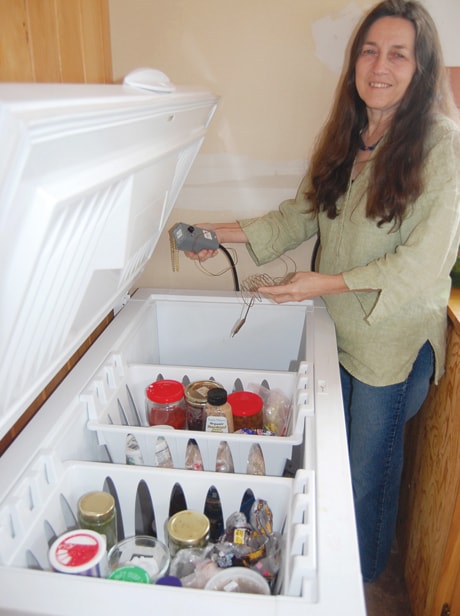MILLVALE, P.E.I. — It’s a given that the second you open your refrigerator door the cold air spills out and the cooling process has to begin again.
But what if there was a fridge that not only retained that cold air with remarkably efficiency but also cost a mere $5 a year to run, compared to about $70 for a 20-some-cubic-foot EnerGuide model.
Environmental advocate Sharon Labchuk of Millvale, northwest of Charlottetown, has discovered that all you need is an ordinary chest freezer and a little external plug-in manual thermostat control device that regulates the interior to standard fridge temperature.
“The cold air is heavier than warm air (so) it stays put,” Labchuk says.
“That’s why this is so energy-efficient. The lid opens up like any chest freezer does so that the cold air stays put. When you open a fridge with a door it’s the least energy-efficient way of refrigeration that you could imagine because all the cold air (spills) out and immediately it’s replaced with warm air that the fridge has to start cooling again.”
Labchuk discovered this interesting twist to the typical kitchen appliance when the energy-efficient refrigerator she purchased in 1993 started going downhill.
Wanting to reduce her electricity consumption, she checked out some of the new super-efficient fridges that are designed to be powered by wind or solar power, but they were extremely expensive. Then she happened upon the website of an Australian scientist who took a regular chest freezer and converted it to a refrigerator. He provided the plans online.
Labchuk was confident she could do it.
“But then one thing led to another and I found that there was already a device that you could buy that did just that. The way these things work is they override the thermostat in your freezer and you can adjust it so that you can change the temperature to whatever you prefer. So you can change it to a refrigerator temperature.”
The plug-in thermostat control, which cost less than $60, is often used by home brewers to convert freezers into fridges for beer kegs.
“It’s all external so it doesn’t affect the warranty (of the freezer). It doesn’t affect the functioning except it changes the setting on the thermostat to a higher setting,” she says.
The device does not come with a precise temperature setting, so Labchuk tucked a thermometer inside her chest freezer and just adjusted the external device until the interior reached normal fridge temperature.
Fortunately for Labchuk, her kitchen was configured so that she could tuck the chest freezer into the spot where her refrigerator once sat.
“(But) even if people don’t have the room in their kitchen to do something like this, many people have extra fridges in their basements or cottages that are old and they’re consuming tons of energy. (They) could certainly replace it with a converted freezer,” she says.
One advantage to having a chest freezer is their lifespan is a lot longer than a refrigerator, she adds.
The disadvantage is that there is no separate compartment for freezer space, but Labchuk already has a large freezer in which she stores her garden harvest.
“This is perfect for me because I grow pretty much all my own vegetables. I don’t buy vegetables anymore. And so in the fall I have a huge glut of things I have to deal with; I have to freeze them or dry them or do something with them,” she says of her freezer fridge.
“(So) I was always trying to ram these big garbage bags full of stuff in my fridge and now I can just heave it in here and deal with it when I get time.”
Labchuk has organized her freezer fridge for ease of access. The things she uses most often are tucked in to the unit’s two sliding baskets and on the shelf, which houses the motor. The rest is put in the bottom.
The cost savings of about $65 annually in electricity is great but not the main reason she has gone this route.
“For me, it was the savings in electricity itself, not so much the cash, where I’m contributing less to climate change by doing this.”
